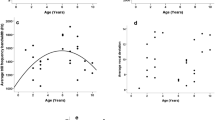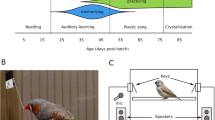Abstract
Male birdsong is generally regarded as a secondary sexual characteristic under the control of gonadal steroids1,2. Song typically waxes and wanes with the seasonal cycle of testicular growth and regression and decreases after adult castration. Testosterone therapy reinstates song, induces it in females, augments it in intact males, and spring testosterone profiles correlate with seasonal song production3–10. Thus, testosterone has been viewed as a major factor in song acquisition and production3,11–14 acting either directly, or after aromatization within the brain15–16. We show here, however, that song learning and early phases of the development of singing both take place in castrated male birds with no significant levels of testosterone in their blood plasma. Testosterone seems to be required for song crystallization, however. Oestradiol was unexpectedly still present after castration, evidently from a non-testicular source, throughout the period of male song acquisition.
This is a preview of subscription content, access via your institution
Access options
Subscribe to this journal
Receive 51 print issues and online access
$199.00 per year
only $3.90 per issue
Buy this article
- Purchase on Springer Link
- Instant access to full article PDF
Prices may be subject to local taxes which are calculated during checkout
Similar content being viewed by others
References
Andrew, R. J. in Bird Vocalizations (ed. Hinde, R. A.) 97–130 (Cambridge University Press, Cambridge, 1969).
Nottebohm, F. in Handbook of Physiology—The Nervous System V. (ed. Plum, F.) 85–108 (American Psychological Association, Washington, 1987).
Pröve, E. in Hormones and Behaviour in Higher Vertebrates (eds Balthazart, J., Pröve, E. & Gilles, R.) 368–374 (Springer, Berlin, 1983).
Arnold, A. P. J. exp. Zool. 191, 309–326 (1975).
Balthazart, J. in Avian Biology, Vol. 7 (eds Farner, D. S., King, J. R. & Parkes, K. C.) 221–365 (Academic, New York, 1983).
Heid, P., Güttinger, H. R. & Pröve, E. Z. Tierpsychol. 69, 224–236 (1985).
Marler, P., Peters, S. & Wingfield, J. J. Neurobiol. 18, 531–548 (1987).
Pohl-Apel, G. & Sossinka, R. Z. Tierpsychol. 64, 330–336 (1984).
Silver, R., O'Connell, M. & Saad, R. in Endocrine Control of Sexual Behavior (ed. Beyer, C.) 223–278 (Raven, New York, 1979).
Wingfield, J. C. in Avian Endocrinology—Environmental and Ecological Perspectives (eds Mikami, S. I., Homma, K. & Wada, M.) 265–288 (Japan Scientific, Tokyo, and Springer, Berlin, 1983).
Nottebohm, F., Nottebohm, M. E., Crane, L. A. & Wingfield, J. C. Behav. Neural Biol. 47, 197–211 (1987).
DeVoogd, T. J. J. Neurobiol. 17, 177–201 (1986).
Nottebohm, F. Ibis 111, 386–387 (1969).
Nottebohm, F. in Progress in Psychobiology and Physical Psychology, Vol. 9, (eds Sprague, J. M. S. & Epstein, A. N. E.) 85–124 (Academic, New York, 1980).
Harding, C. in Hormones and Behaviour in Higher Vertebrates (eds Balthazart, J., Pröve, E. & Gilles, R.) 275–289 (Springer, Berlin, 1983).
Hutchison, J. B. & Steimer, Th. in Hormones and Behaviour in Higher Vertebrates (eds Balthazart, J., Pröve, E. & Gilles, R.) 261–273 (Springer, Berlin, 1983).
Wingfield, J. C. & Farner, D. S. Steroids 26, 311–327 (1975).
Marler, P. & Peters, S. Auk 99, 446–458 (1982).
Marler, P. & Peters, S. Ethology 76, 89–100 (1987).
Marler, P. & Peters, S. Ethology 77, 76–84 (1988).
Arnold, A. P. J. exp. Zool. 191, 261–278 (1975).
Kroodsma, D. E. Anim. Behav. 34, 1572–1575 (1986).
Weichel, K., Schwager, G., Heid, P., Güttinger, H. R. & Pesch, A. Ethology 73, 281–294 (1986).
Adkins-Regan, E. in Hormones and Behaviour in Higher Vertebrates (eds Balthazart, J., Pröve, E. & Gilles, R.) 218–228 (Springer, Berlin, 1983).
Arnold, A. P., Bottjer, S. W., Brenowitz, E. A., Nordeen, E. J. & Nordeen, K. W. Brain Behav. Evol. 28, 22–31 (1986).
Hutchison, J. B., Wingfield, J. C. & Hutchison, R. E. J. Endocr. 103, 363–369.
Konishi, M. & Gurney, M. E. Trends Neurosci. 5, 20–23 (1982).
Nottebohm, F. Brain Res. 189, 429–436 (1980).
Konishi, M. & Akutagawa, E. Brain Res. 222, 442–446.
Nottebohm, F. Science 214, 1368–1370 (1981).
Author information
Authors and Affiliations
Rights and permissions
About this article
Cite this article
Marler, P., Peters, S., Ball, G. et al. The role of sex steroids in the acquisition and production of birdsong. Nature 336, 770–772 (1988). https://doi.org/10.1038/336770a0
Received:
Accepted:
Issue Date:
DOI: https://doi.org/10.1038/336770a0
This article is cited by
-
A cross-sectional field study of fall song in Northern Mockingbirds Mimus polyglottos
Journal of Ornithology (2021)
-
Neuroestrogen synthesis modifies neural representations of learned song without altering vocal imitation in developing songbirds
Scientific Reports (2020)
-
Importance of investing in adolescence from a developmental science perspective
Nature (2018)
-
Aromatase inhibition rapidly affects in a reversible manner distinct features of birdsong
Scientific Reports (2016)
-
High throughput analysis reveals dissociable gene expression profiles in two independent neural systems involved in the regulation of social behavior
BMC Neuroscience (2012)
Comments
By submitting a comment you agree to abide by our Terms and Community Guidelines. If you find something abusive or that does not comply with our terms or guidelines please flag it as inappropriate.



